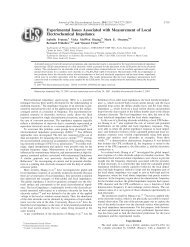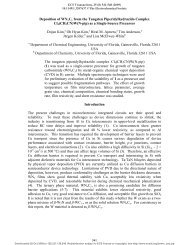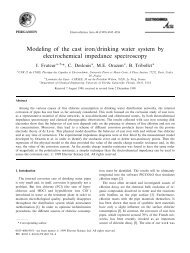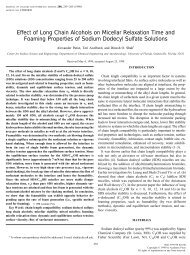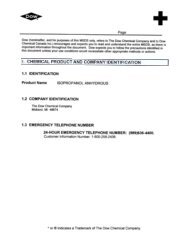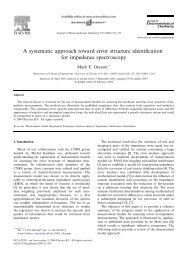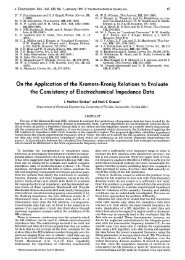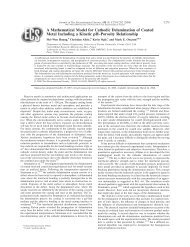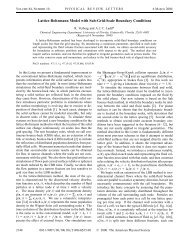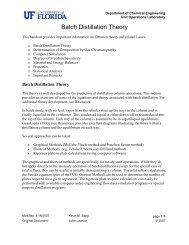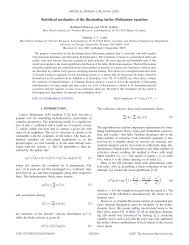Measurement Models for Electrochemical Impedance Spectroscopy ...
Measurement Models for Electrochemical Impedance Spectroscopy ...
Measurement Models for Electrochemical Impedance Spectroscopy ...
Create successful ePaper yourself
Turn your PDF publications into a flip-book with our unique Google optimized e-Paper software.
4150 J. Electrochem. Soc., Vol. 142, No. 12, December 1995 9 The <strong>Electrochemical</strong> Society, Inc.plication to the interpretation of optical spectra is underdevelopment, knowledge of the error structure has beenshown to allow enhanced interpretation of light scatteringmeasurements in terms of particle size distribution or evenparticle classification, n'~2Identification of the error structure <strong>for</strong> most radiationbasedspectroscopic measurements such as light scatteringcan be accomplished by calculating the standard deviationof replicate measurements. The error analysis approach hasbeen successful <strong>for</strong> light spectroscopy measurements becausethese systems lend themselves to replication and,there<strong>for</strong>e, to the independent identification of the differenterrors that contribute to the total variance of the measurements.In contrast, the stochastic contribution to the errorstructure of electrochemical impedance specfroscopy measurementsgenerally cannot be obtained from the standarddeviation of repeated measurements because even a mildnonstationary behavior introduces a nonnegligible timevaryingbias contribution to the error.The discussion of error structures in impedance spectroscopy,there<strong>for</strong>e, has been limited to a priori predictionsof measurement noise based on instrument noise ~3 and tostandard assumptions concerning the error structure suchas constant or proportional errors. ~4-~6 Zoltowski reports anexperimental assessment of the stochastic noise at selectedfrequencies which showed that the standard deviation ofthe real and imaginary parts of the impedance (and admittance)are correlated. ~7 This result was used to defend theuse of modulus weighting <strong>for</strong> regression of models to experimentaldata. ~749 Attempts to weight regressions by standarddeviations determined from repeated impedancescans (e.g., Ref. 20) have not been successful because thestandard deviation obtained from repeated impedancemeasurements includes both bias and stochastic contributionsto the error structure. Our objective here is topresent a procedure <strong>for</strong> assessing the stochastic contributionto the error structure of impedance measurements andto develop a model <strong>for</strong> the stochastic noise of impedancemeasurements.Knowledge of the error structure is essential in assessingexperimental technique and can play a role in determiningthe influence of instrumental strategies. For example, useof matched filters <strong>for</strong> the input of the frequency responseanalyzer has been proposed to be an appropriate technique<strong>for</strong> reducing the noise in impedance spectra. 2~ While thereduction of the noise in input signal can be readily seen bythe display of an oscilloscope, a method <strong>for</strong> assessing thenoise in the ultimate measurement is essential in decidingwhether the filters contribute to reduction of noise in theimpedance spectra.Knowledge of the error structure is also needed <strong>for</strong> analysisof experimental data. For example, proper weightingduring nonlinear regression of a model to impedance datais necessary to get unbiased parameter estimates. ~~ Aweighted least squares strategy that includes the errors inthe real and imaginary parts of the impedance is given byminimization of(Zr, k - Zr, k) 2 (Zj,k -- Zj,k) 2J= E ~ + ~ -' 2 ' [11k O'r,k O'j,kwhere Zr, k and Zi,k represent the real and imaginary part ofthe data, respectively, the caret signifies the correspondingmodel value, and cry, k and %,~ are the real and imaginary partof the standard deviation at each frequency. The use of thevariance to weight data ensures that data points with "lownoise" content are emphasized and the data points with"high noise" content are de-emphasized. Use of the experimentallydetermined variance <strong>for</strong> weighting has beenshown to increase the amount and quality of the in<strong>for</strong>mationthat can be obtained from impedance measurements3Classification of <strong>Measurement</strong> ErrorsThe residual errors (e~J that arise when a model is regressedto experimental data can be described as beingcomposed of deterministic (systematic) and stochastic(randomly distributed) contributions, Esyst and es~ooh, respectively.Thus, at any given frequencyZ - Z = ere~ = esy~t + e~toch [2]where the caret signifies the model value <strong>for</strong> the compleximpedance Z. The presence of stochastic errors estooh in anyexperimental data is inevitable. In this work, the systematicerrors that result from model inadequacies are distinguishedfrom the experimental errors that are propagatedthrough the model and that could arise from a changingbase line or from instrumental artifacts. Systematic errorsare there<strong>for</strong>e defined to consist of contributions from thelack of fit of the model to the data (elo~) and a bias (%~as) inthe experiment, i.e.%s~ = elo~ + eblas [3]In principle, improvement of a stationary model reducesthe error associated with a lack of fit, but nonstationarybehavior (%s) and instrumental artifacts (eJ can still contributeto the bias errors, i.e.eb~ = en~ + ei~ [4]The nonstationary contribution to the bias usually is observedmost easily at frequencies that require the longesttime <strong>for</strong> measurement. Instrumental artifacts may be seenat high frequency resulting from equipment limitations.Many, if not most, electrochemical systems show at least amild nonstationary behavior due to changes in electrodeproperties during the course of an experiment. In contrast,solid-state systems, as a first approximation, may be assumedto be stationary. <strong>Impedance</strong> data can be corruptedby instrumental artifacts <strong>for</strong> both electrochemical andsolid-state systems.The emphasis in regression of models to impedance datais on reducing the error associated with a lack of fit, but itis evident that the residual errors must contain contributionsassociated with phenomena that are independent ofthe adequacy of the model, i.e.Z - 2 = e~o~ + (ens + ei~) + e~o~h [5]The object here is to quantify the stochastic errors inimpedance measurements. The quantification of bias errorsassociated with experimental issues such as instrumentalartifacts or nonstationary phenomena will be addressedin a subsequent paper. 9Identification of Error StructureThe method <strong>for</strong> assessing the stochastic part of the errorstructure is based on using a measurement model as a filter<strong>for</strong> nonreplicacy of impedance data. The measurementmodel is composed of a superposition of line shapes whichcan be chosen arbitrarily. A model composed of Voigt elementsin series with a solution resistance has been shown tobe a useful and general measurement model (see Fig. 1 inRef. 8). While the line shape parameters may not be associatedunequivocally with a set of deterministic or theoreticalparameters <strong>for</strong> a given system, the measurement-modelapproach has been shown to represent adequately theimpedance spectra obtained <strong>for</strong> a large variety of electrochemicalsystems.8 The characteristic time constants <strong>for</strong>the line shapes and their dispersion are low frequency ascompared to the noise. The line shape models there<strong>for</strong>e canbe said to represent the low-frequency stationary componentsof the impedance spectra (in a Fourier sense). Regard]essof their interpretation, the measurement modelrepresentation can be used to filter and thus identify thenonstationary (drift) and high frequency (noise) componentscontained in the same impedance spectrum.It is not obvious that such an approach should work. It iswell known, <strong>for</strong> example, that the impedance spectrum associatedwith an electrochemical reaction limited by therate of diffusion through a stagnant layer (the Warburgimpedance) can be approximated by an infinite number ofresistance-capacitance (RC) circuits in series (the Voigtmodel). In theory, then, a measurement model based on theVoigt circuit should require an infinite number of parametersto describe adequately the impedance response of any



